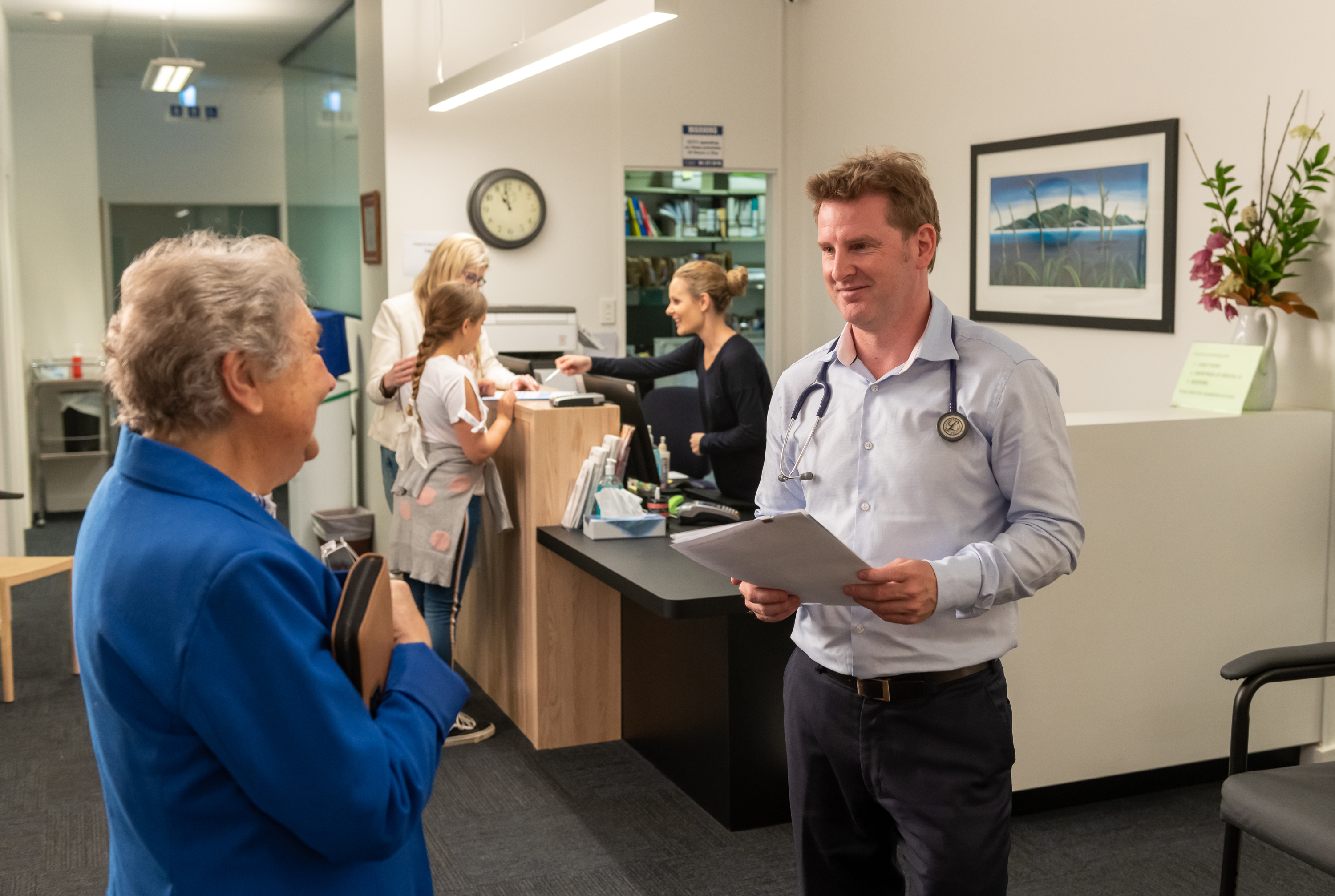Getting started
Hei tīmatanga
Whether you’ve recently registered with us as a health provider, have a new employee joining your practice or simply need a refresher, you’ll find all the information and resources you need to get started with us, quickly.
Let's work together. Here's how.
Video transcript for Welcome to ACC
Visual
Title screen shows The everything you need to know and nothing you don’t guide to the fundamentals of ACC.
Clock shows watch time 12 minutes 22 seconds.
The word Go shows. Screen changes to show welcome to ACC101.
Transcript
Megan Main: Kia ora and welcome to ACC.
Visual
Text displays Megan Main Chief Executive Officer.
Megan is sitting in a chair facing the camera. A pot plant, water jug, cup of water and pen and notepad sit in a small table beside her.
Transcript
If you’ve recently registered with us, congratulations! We’re happy to have you on board In this introductory video, we’re going to explain some of the essentials of working with us. What ACC is, what we cover, how we work together, and how to lodge a claim. Even if you’ve worked with us for a while, there’s some important information about ACC and how we can work well together. Right, let’s get into it.
Visual
Screen shows Chapter 1 What is ACC? Clock shows watch time of 2 minutes 31 seconds.
Screen cuts back to Megan in the chair.
Transcript
To understand ACC, we need to understand how healthcare works in Aotearoa New Zealand. As a country, we fund healthcare differently to others. When someone gets injured as a result of an accident, they can come to us, the Accident Compensation Corporation, or ACC, for support. That support can come in many forms and will depend on what our clients need to get back to independence. It could be treatment, it could be weekly compensation, rehabilitation equipment, counselling for mental injury or help getting back to work.
Visual
Screen shows What does ACC do? Clock shows watch time of 30 seconds.
Screen changes to show Helping recovery and preventing accidents.
Screen cuts back to Megan in the chair.
Transcript
Put simply, we provide comprehensive, no-fault injury cover for New Zealanders, as well as for our visitors. To do this, we partner with providers like you to deliver healthcare services to our clients. But our work doesn’t end there. We believe that up to 90 percent of all injury claims are preventable. That’s why we’re also focused on injury prevention to stop accidents happening in the first place.
Visual
Screen shows Who is covered? Clock shows watch time of 26 seconds.
Screen changes to show Everyone is eligible.
Screen cuts back to Megan in the chair.
Transcript
Everyone in Aotearoa New Zealand is eligible for cover, meaning they can get the treatment and care that they need to recover from injury. We take a no-fault approach to accident cover, meaning it doesn't matter who you are or what you were doing when you were hurt. Even our visitors can get cover for treatment if they’re hurt in an accident here.
Visual
Screen shows How is ACC funded? Clock shows watch time of 30 seconds.
Screen changes to show We all pay for each other.
Screen cuts back to Megan in the chair.
Transcript
All New Zealanders contribute to keeping ACC running so we can keep caring for each other. We’re funded by different levies paid by motorists, businesses, and workers. We’re also partly government funded. We invest and grow that money to pay for the future costs of the scheme. That’s just a brief introduction about our mission and what we do at here ACC, but of course there’s plenty more to learn. It’s good to have you on this journey.
Visual
Screen shows Chapter one What is ACC?
Screen changes to roll through three statements: ACC supports people injured in accidents regardless of who they are and how they were hurt. We work with you to get clients back to independence. All New Zealanders contribute to keep ACC running.
Screen changes to show Chapter 2 What ACC covers. Clock shows watch time of 3 minutes 5 seconds.
Text displays Dr Dilky Rasiah Strategic Clinical Advisor.
Dilky is sitting in a chair facing the camera. A pot plant, water jug, cup of water and pen and notepad sit in a small table beside her.
Transcript
Dr Dilky Rasiah: Cover can be a bit of a tricky area and it’s a term you’ll probably hear a lot. We’re going to get into the basics of what we mean by cover. What’s included and what’s not.
Visual
Screen shows When claim meets criteria. Clock shows watch time of 16 seconds.
Screen cuts back to Dilky in the chair.
Transcript
At its core, cover means the claim meets the criteria set out in our legislation. If it does, we’ll contribute to, or fully fund, the treatment or support you provide.
Visual
Screen shows Who is covered? Clock shows watch time of 20 seconds.
Screen changes to show Anyone injured in an accident.
Screen cuts back to Dilky in the chair.
Transcript
Anyone in New Zealand injured in an accident is eligible for cover. It doesn’t matter who they are or what they were doing at the time. That also extends to those visiting us from overseas.
Visual
Screen shows What’s covered? Clock shows watch time of 37 seconds.
Screen changes to show Physical injuries caused by accidents.
Screen cuts back to Dilky in the chair.
Transcript
To cover a claim, we need to know that the person’s injury is caused by an accident. That’s what we call causation. For simple claims, like if someone falls off their bike and dislocates their shoulder, causation is easy to see and we can make our decision quickly. But there will be times we will need more information from you or another clinician. Injuries should have evidence of physical damage from the accident.
Visual
Screen shows Other kinds of injuries? Clock shows watch time of 23 seconds.
Screen cuts back to Dilky in the chair.
Transcript
But we don’t just cover one-off physical injuries. We also cover mental injury linked to physical harm, a traumatic event at work or a criminal act. It also extends to when a person is injured during treatment, and diseases or infections linked to a person’s job or work environment.
Visual
Screen shows What’s not covered? Clock shows watch time of 19 seconds.
Screen changes to show Anything not caused by an accident.
Screen cuts back to Dilky in the chair.
Transcript
While we do cover a lot of different injuries, there are some things we can’t cover. Generally speaking, these are things not linked to accidents, are part of the natural ageing process, or are pre-existing conditions.
Visual
Screen shows What if something changes? Clock shows watch time of 24 seconds
Screen changes to show Keep us in the loop
Screen cuts back to Dilky in the chair
Transcript
If your patient is covered and their diagnosis changes, you need to let us know. The support we provide is based on their current injury so if things change, we might need to adjust their level of support to meet their new needs. So, there you have it. That’s the basics of cover, covered!
Visual
Screen shows Chapter two What ACC covers.
Screen changes to roll through four statements: Cover is when a claim meets criteria in legislation. Cover needs causation – a link between injury and accident. Cover also includes mental and treatment injuries. A change in diagnosis could mean a change in support levels.
Screen changes to show Chapter 3 Your responsibilities. Clock shows watch time of 3 minutes 31 seconds.
Screen changes and text displays Dr John Robson Chief Clinical Officer.
John is sitting in a chair facing the camera. A pot plant, water jug, cup of water and pen and notepad sit in a small table beside him.
Transcript
Dr John Robson: At ACC, we want injured people to receive the appropriate care and treatment for their needs, but we can't do it without you. Here are a few things to know about our expectations now that you’ve joined us.
Visual
Screen shows Understanding ACC. Clock shows watch time of 14 seconds.
Screen cuts back to John in the chair.
Transcript
One of the most important parts of ensuring everyone gets the support they need is to first make sure we all understand our roles and responsibilities. And we want you to have an appropriate understanding of ACC and how we will be working together.
Visual
Screen shows What are my responsibilities? Clock shows watch time of 42 seconds.
Screen cuts back to John in the chair.
Transcript
When you’re providing treatment to injured people on our behalf, you have some key responsibilities. Act in keeping with your professional body standards and the ACC legislation. Follow our policies and procedures. Maintain appropriate professional clinical records. Provide us with reports and patient notes as requested. Invoice us appropriately, transparently, and on time. Ensure the quality of your treatment. And represent us fairly. Ultimately, it’s all about acting with professionalism, transparency and integrity.
Visual
Screen shows How can I make sure I fulfil my responsibilities? Clock shows watch time of 27 seconds.
Screen changes to show Get to know our Working Together handbook.
Screen cuts back to John in the chair.
Transcript
A good place to start is our Working Together handbook, which you can find on our website. If you’re working under Cost of Treatment Regulations, this will be your guide to understanding our expectations and your responsibilities. Being familiar with it will help ensure your patients receive treatment that helps them to return to work and everyday life as safely and quickly as possible.
Visual
Screen shows Understand your contract. Clock shows watch time of 18 seconds.
Screen cuts back to John in the chair.
Transcript
If you’ve signed up to one of our contracts, make sure you’re familiar with your relevant Service Schedule and Operational Guidelines. These are updated with changes in regular cycles, but we’ll let you know ahead of time when this is happening.
Visual
Screen shows Read our Position Statements. Clock shows watch time of 17 seconds.
Screen cuts back to John in the chair.
Transcript
It is important that you read and understand our Position Statements on key issues such as treating your friends and family, providing treatment in a sports setting, same day allied health treatment, and treatment by allied health students.
Visual
Screen shows Be culturally competent. Clock shows watch time of 42 seconds.
Screen cuts back to John in the chair.
Transcript
And finally, Aotearoa New Zealand has a diverse population and that’s also reflected in the people we support. We want you to deliver your services in a culturally competent manner. This recognises the needs of Māori by understanding, respecting, and delivering services in line with the key principles and frameworks in the New Zealand Māori Health Strategy, He Korowai Oranga. Our cultural safety and competency guidelines will also help you to improve access and deliver appropriate advice, care, and treatment. Being clear on these important issues from the start means we can focus on our shared goals of improving lives, every day.
Visual
Screen shows Chapter three Your responsibilities are to.
Screen rolls through four statements: Act with professionalism, accuracy, integrity. Be familiar with our Working Together handbook. Understand our Position Statements. Be culturally competent.
Screen changes to show Chapter 4 How to lodge a claim. Clock shows watch time of 2 minutes 51 seconds.
Screen changes and text displays Emma Clabburn Clinical Advisor.
Emma is sitting in a chair facing the camera. A pot plant, water jug, cup of water and pen and notepad sit in a small table beside her.
Transcript
Emma Clabburn: Lodging a claim is the entry point into the ACC scheme and allows injured New Zealanders to access appropriate support. That’s why it’s important this is done correctly the first time. So, if you’re new to claims and think your patient has an injury we cover, here’s what you need to know about lodging one.
Visual
Screen shows Where can I lodge a claim? Clock shows watch time of 22 seconds.
Screen changes to show Lodge a claim online.
Screen cuts back to Emma in the chair.
Transcript
The best and most efficient way to lodge a claim is online using a Practice Management System or our eBusiness Gateway. There’s more information on our website about what you’ll need to get set up, what ACC services your Practice Management vendor may offer, and our online lodgement services which are available for all providers.
Visual
Screen shows How do I lodge a claim? Clock shows watch time of 36 seconds.
Screen changes to show Before you start: 1. Register with ACC. 2. Make sure you can lodge a claim. 3. Check if you patient’s injury is one we cover.
Screen cuts back to Emma in the chair.
Transcript
Before you fill out the claim form, there are a couple of things to get sorted first. If you’re not already, you need to be registered with us. Check you can lodge a claim. Most treatment providers, such as registered health professionals and locums can do it, but there are some exceptions. You will need to be able to identify the accident and the related injury. Finally, make sure you have all the information about your patient, the injury, and the accident ready.
Visual
Screen shows Lodging a claim: 1. Fill out an ACC45 form. 2. Get patient declaration and consent. Clock shows watch time of 26 seconds.
Screen cuts back to Emma in the chair.
Transcript
Once you’ve gathered all the information, you can start by filling out an ACC45 form. Make sure you use the correct Read code, and always get the patient’s declaration and their consent. There’s a specific Read code to match a person’s diagnosis or injury type. These help us make sure the appropriate cover and support is in place. You can find out more about Read codes on our website.
Visual
Screen shows What happens next? Clock shows watch time of 41 seconds.
Screen changes to show Claim accepted. Patient notified. We may contact you about complex claims.
Screen cuts back to Emma in the chair.
Transcript
After you’ve lodged a claim, we'll check if it meets cover criteria. Straightforward online claims are automated, and a decision can often be made on the same day. If that’s the case, your patient may receive a text message about our cover decision. The easiest way for you to check the status of the claim is to use your Practice Management System or our online system. For more complex, manual, and non-acute dental claims we’re likely to need a bit more time to make a decision. We'll get in touch with you if we need more information about the claim. So, that’s the essentials of lodging a claim. Now you’re ready do it yourself!
Visual
Screen shows Chapter four How to lodge a claim.
Screen rolls through three statements: Make sure you have everything on hand before you start. Fill out an ACC45 form online. We’ll get in touch if we need more information.
Screen changes and cuts back to Megan Main sitting in a chair facing the camera.
Transcript
Thanks so much for watching this introduction to the essentials of working successfully with ACC, it’s great to have you on board. If you need more information on any of the topics we’ve covered, you’ll find everything you need on our website. I know that with your help we can keep improving the lives of injured people across Aotearoa.
Visual
Screen changes to show For more information and resources visit acc.co.nz/health-providers.
Screen changes again to show the ACC logo and tagline He Kaupare. He Manaaki. He Whakaora. Prevention. Care. Recovery.
This educational video is designed to give you the information you need in four short chapters, including what we do, your responsibilities as a health provider, cover, and lodging claims.




